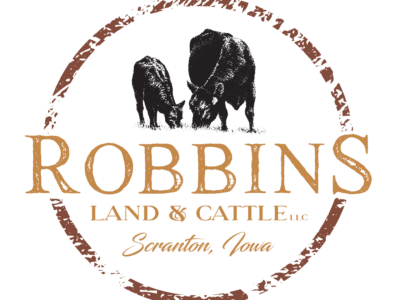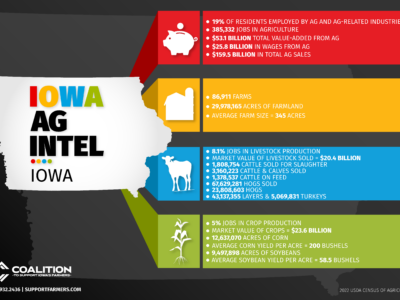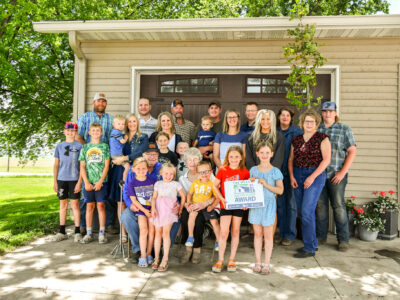Coming Back to the Family Farm
02-01-2016 in Livestock
Bringing the Next Generation Back to the Farm was the theme of the day as more than 200 beginning farmers gathered in Ames, January 21, for the 11th annual Farming for the Future Conference, hosted by the Coalition to Support Iowa’s Farmers.
Since its formation in 2004, CSIF has helped more than 3,400 livestock farmers, many of them just getting into the business or expanding their operations, by helping navigate the regulatory and financial landscape.
For many, coming back to the farm means stepping into the family business. Dave Baker, Farm Transition Specialist with the Iowa State University Beginning Farmer Center, highlighted the need for communication throughout the process.
“Lack of communication is at the core of conflict in a family business,” said Baker. “It’s important to define roles and relationships. Have a job description. Have a clear picture of how you intend to live and work together.”
Succession planning is not the same as estate planning. Succession planning is about continuation of the farm business, and that doesn’t always involve a family member. Opportunities abound for young farmers to align themselves with a neighbor or employer who is looking for a successor.
Whether it’s family or non-family, passing the farm onto the next generation often means expansion. It may require added acres or added livestock to support two families. CSIF offers assistance with expansion projects as well as connections to programs that aid in the transition.
“There are unlimited opportunities to grow Iowa’s livestock industry, but farmers have to have a plan for growth,” said Brian Waddingham, executive director of CSIF. “We go out and meet with the family, sit down with them to understand where they are today and where they want to be in the future. Then our job is to help them get there.”
It takes good business management to move a farming operation from one generation to the next; it also takes a firm commitment. “You have to want to farm,” said conference keynote speaker Mike Pearson, host of the nationally syndicated Market to Market television show. “You can’t do it if you don’t enjoy it.”
Baker stressed a long-term plan, as did Iowa Farm Bureau Farm Business Development Manager Amanda Van Steenwyk. In her presentation she emphasized clarifying the vision with traditionally corporate tools such as vision and mission statements, and the use of SMART goals – Specific, Measurable, Attainable, Relevant, Time-bound.
Pearson said he has used the SMART approach, as well as a confidential consultation with CSIF Field Specialist Kent Mowrer, in growing his own operation, Genuine Pearson Cattle Company.
Delving further into planning strategies that include strategic planning, sensitivity analysis, and evaluation, Van Steenwyk highlighted the need for an advisory team of associated professionals, including the CSIF team.
“Our mission of helping Iowa’s farm families grow successfully and responsibly is still as important today as it was eleven years ago,” said Waddingham. “Our pre-emptive approach of helping farmers start raising livestock or grow their existing farms has proven to be successful – and in many cases – essential to reaching the farm families goals.”
“There are a lot of challenges out there today,” said Pearson, as he outlined current and projected market trends. Structural changes in how commodities are priced over the past 18 months have created marketing headaches and a strong dollar has hampered export growth. The forces have combined to make non-ag investment less attractive.
“That means the futures market is a less viable tool for producers,” said Pearson, counseling producers to embrace the challenge. “Sell at break even and manage risk with a call. Be aggressive with your marketing.”
While he offered advice for working through the “financialization of everything” and the anticipated negative market forces of the next couple of years, he said he sees light at the end of the tunnel. “If you go back 15 years or so and look at the numbers, you see hard times. And we made it through. We will again.”
He urged beef producers to find ways to capture feedlot margins through retained ownership by self or custom feeding. He urged pork producers to “sell when you can, not when you have to.”
A worldwide growing middle class continues to create new markets for meat exports. The need to feed 9 billion people by 2050 is very real – and this time, they want protein. “The difference with this population spurt over past growth is the growth of per capita wealth, not just population,” said Pearson. “It’s not just number of mouths, it’s number of wallets.”
That translates into opportunity for Iowa livestock producers of all ages. “Manage aggressively, tell your story, and prepare to reap the benefits,” said Pearson.
And call CSIF to get started today!
By Terri Queck-Matzie for CSIF
Recommended News

Robbins Family Hosts Cattle Building Open House
Farmers interested in learning about the benefits of raising cattle under roof are invited to attend an open house at the Robbins family farm to tour Justin and Lacie Robbins...
Read More
NEW STUDY SHOWS IOWA AGRICULTURE EVEN STRONGER
Iowa’s 86,911 family farms continue to be a key driver of Iowa’s economy, contributing 32 percent more to the state economy than in 2017, according to a new study commissioned...
Read More
Farming is a Family Affair
The Streit family of West Bend, Iowa, has cultivated their farm for over three decades, fostering a legacy of hard work and community support. Diane and Tony Streit, alongside their...
Read More